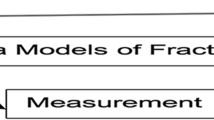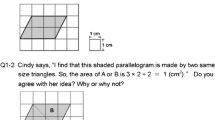Abstract
The purpose of this study was to explore the ways elementary pre-service teachers responded to hypothetical student misconceptions about area measurement topics, framed in the context of their existing understanding and the Mathematical Knowledge for Teaching framework. Data collection consisted of written pre-assessments, followed by semi-structured interviews with 24 pre-service teachers enrolled in a geometry and measurement course. Findings included a frequent misattribution of area understanding to students, tendencies to provide alternate procedural strategies or re-explain concepts, and key differences in pedagogical strategies depending on initial content knowledge or apparent correctness of the student response. While there existed a tendency among some pre-service teachers to encourage procedural approaches, several others were able to leverage their own understanding towards conceptual, student-centered instructional responses. Such responses placed the student at the center of the instructional interaction, paving the way for exploration and mathematical discovery. Recommendations for supporting pre-service teachers in navigating the intersection between content and pedagogical knowledge in area measurement are discussed.




Similar content being viewed by others
References
Ball, D. L., Thames, M. H., & Phelps, G. (2008). Content knowledge for teaching: what makes it special? Journal of Teacher Education, 59(5), 387–407.
Baturo, A., & Nason, R. (1996). Student teachers’ subject matter knowledge within the domain of area measurement. Educational Studies in Mathematics, 31(3), 235–268. https://doi.org/10.1007/bf00376322.
Baumert, J., Kunter, M., Blum, W., Brunner, M., Voss, T., Jordan, A., … Tsai, Y. M. (2009). Teachers’ mathematical knowledge, cognitive activation in the classroom, and student progress. American Educational Research Journal, 47(1), 133–180. https://doi.org/10.3102/0002831209345157.
Busi, R., & Jacobbe, T. (2014). Examining student work in the preparation of preservice elementary school teachers. The Mathematics Educator, 23(2), 23–39.
Chamberlin, M., & Candelaria, M. S. (2014). Investigating area and volume instruction for prospective teachers: a lesson experiment. Mathematics Education, 9(2), 113–134.
Charalambous, C. Y. (2010). Mathematical knowledge for teaching and task unfolding: an exploratory study. The Elementary School Journal, 11(3), 247–278.
Ding, M., Li, X., & Capraro, M. M. (2013). Preservice elementary teachers’ knowledge for teaching the associative property of multiplication: a preliminary analysis. The Journal of Mathematical Behavior, 32(1), 36–52. https://doi.org/10.1016/j.jmathb.2012.09.002.
Hiebert, J., & Lefevre, P. (1986). Conceptual and procedural knowledge in mathematics: an introductory analysis. In J. Hiebert (Ed.), Conceptual and procedural knowledge: the case of mathematics. Hillsdale: Lawrence Erlbaum Associates.
Hill, H. C., Rowan, B., & Ball, D. L. (2005). Effect of teachers’ mathematical knowledge for teaching on student achievement. American Educational Research Journal, 42(2), 371–406.
Hill, H. C., Blunk, M. L., Charalambous, C. Y., Lewis, J. M., Phelps, G. C., Sleep, L., & Ball, D. L. (2008). Mathematical knowledge for teaching and the mathematical quality of instruction: an exploratory study. Cognition and Instruction, 26(4), 430–511.
Kamii, C., & Kysh, J. (2006). The difficulty of “length x width”: is a square the unit of measurement? The Journal of Mathematical Behavior, 25(2), 105–115. https://doi.org/10.1016/j.jmathb.2006.02.001.
Kospentaris, G., Spyrou, P., & Lappas, D. (2011). Exploring students’ strategies in area conservation geometrical tasks. Educational Studies in Mathematics, 77(1), 105–127. https://doi.org/10.1007/s10649-011-9303-8.
Livy, S., Muir, T., & Maher, N. (2012). How do they measure up? Primary pre-service teachers’ mathematical knowledge of area and perimeter. Mathematics Teacher Education and Development, 14(2), 91–112.
Maher, N., & Muir, T. (2013). “I know why you have to put down a zero, but I’m not sure why”: exploring the link between pre-service teachers’ content and pedagogical content knowledge. Mathematics Teacher Education and Development, 15(1), 72–87.
Menon, R. (1998). Preservice teachers’ understanding of perimeter and area. School Science and Mathematics, 98(7), 361–368.
Murphy, C. (2012). The role of subject knowledge in primary prospective teachers’ approaches to teaching the topic of area. Journal of Mathematics Teacher Education, 15(3), 187–206. https://doi.org/10.1007/s10857-011-9194-8.
National Council of Teachers of Mathematics. (2014). Principles to actions: ensuring mathematical success for all. Reston: NCTM.
Reinke, K. S. (1997). Area and perimeter: preservice teachers’ confusion. School Science and Mathematics, 97, 75–77.
Sarama, J., & Clements, D. H. (2009). Early childhood mathematics education research: learning trajectories for young children. New York: Routledge.
Schulman, L. S. (1986). Those who understand: knowledge growth in teaching. Educational Researcher, 15(2), 4–14.
Son, J. (2013). How preservice teachers interpret and respond to student errors: ratio and proportion in similar rectangles. Educational Studies in Mathematics, 84(1), 49–70. https://doi.org/10.1007/s10649-013-9475-5.
Son, J. (2016a). Moving beyond a traditional algorithm in whole number subtraction: preservice teachers’ responses to a student’s invented strategy. Educational Studies in Mathematics, 93(1), 105–129. https://doi.org/10.1007/s10649-016-9693-8.
Son, J. (2016b). Preservice teachers’ response and feedback type to correct and incorrect student-invented strategies for subtracting whole numbers. The Journal of Mathematical Behavior, 42, 49–68. https://doi.org/10.1016/j.jmathb.2016.02.003.
Son, J., & Crespo, S. (2009). Prospective teachers’ reasoning and response to a student’s non-traditional strategy when dividing fractions. Journal of Mathematics Teacher Education, 12, 235–261.
Son, J., & Sinclair, N. (2010). How preservice teachers interpret and respond to student geometric errors. School Science and Mathematics, 110(1), 31–46. https://doi.org/10.1111/j.1949-8594.2009.00005.x.
Tchoshanov, M. A. (2011). Relationship between teacher knowledge of concepts and connections, teaching practice, and student achievement in middle grades mathematics. Educational Studies in Mathematics, 76(2), 141–164.
Zacharos, K. (2006). Prevailing educational practices for area measurement and students’ failure in measuring areas. The Journal of Mathematical Behavior, 25(3), 224–239. https://doi.org/10.1016/j.jmathb.2006.09.003.
Author information
Authors and Affiliations
Corresponding author
Additional information
Publisher’s note
Springer Nature remains neutral with regard to jurisdictional claims in published maps and institutional affiliations.
Rights and permissions
About this article
Cite this article
Runnalls, C., Hong, D.S. “Well, they understand the concept of area”: pre-service teachers’ responses to student area misconceptions. Math Ed Res J 32, 629–651 (2020). https://doi.org/10.1007/s13394-019-00274-1
Received:
Revised:
Accepted:
Published:
Issue Date:
DOI: https://doi.org/10.1007/s13394-019-00274-1




